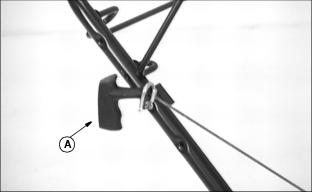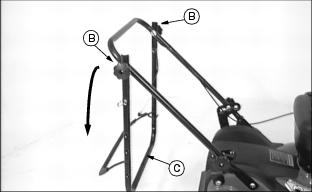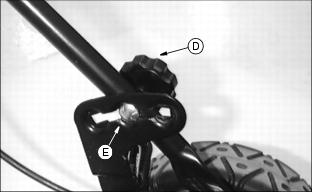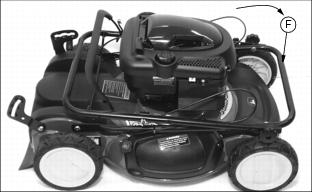21-Inch Walk-Behind Rotary Mowers
Introduction
Product Identification
Safety
Operating
Replacement Parts
Service Intervals
Service
Troubleshooting
Storing Machine
Assembly
Specifications
Warranty
John Deere Quality Statement
Service Record

Storing Machine
Storing Safety
Preparing Machine for Storage
1. Repair any worn or damaged parts. Replace parts if necessary. Tighten loose hardware.
4. Paint scratched or chipped metal surfaces to prevent rust.
5. Apply light coat of engine oil to pivot and wear points to prevent rust.
NOTE: Properly preparing your engine for storage will make it easier to start the following season. Engine storage procedure should be used if mower is not used for longer than 60 days.
There are two satisfactory methods of preparing the engine for storage: running the engine completely dry of fuel, or filling the fuel tank with a mixture of fresh fuel and fuel stabilizer.
Running engine dry of fuel:
NOTE: Try to anticipate the last time the mower will be used for the season so very little fuel is left in the fuel tank.
1. Stop mower in a well-ventilated area.
2. Turn on engine and allow to run until it runs out of fuel.
Add fuel and stabilizer mixture to tank:
IMPORTANT: Avoid damage! Be sure fuel is fresh when adding fuel stabilizer. Fuel stabilizers are ineffective when added to fuels that are more than 30 days old. |
1. Stop mower in a well-ventilated area.
2. Mix fresh fuel and fuel stabilizer in separate container. Follow stabilizer instructions for mixing.
NOTE: Filling the fuel tank reduces the amount of air in the fuel tank and helps reduce deterioration of fuel.
3. Fill fuel tank with stabilized fuel.
4. Run engine for a few minutes to allow fuel mixture to circulate through carburetor.
6. Change engine oil and filter while engine is warm.
7. Service air filter if necessary.
8. Clean debris from engine air intake screen.
9. Remove spark plug. Put 30 mL (1 oz.) of clean engine oil in cylinders.
10. Install spark plug, but DO NOT connect spark plug wire.
11. Crank the engine for approximately five seconds to allow oil to be distributed.
12. Clean the engine and engine compartment.
13. Store the mower in a dry, protected place. If mower is stored outside, put a waterproof cover over it.
Fold Handles
1. Remove grass bag and bagging chute if installed.
2. Remove starter handle (A) from rope guide.
3. Loosen knob (B) 25 mm (1 in.) on each side. Allow upper handle (C) to pivot down.
4. Remove knob (D) and carriage bolt (E) from each side.
5. CAREFULLY fold lower handle (F) forward. Guide cables inside lower handle. DO NOT CRIMP CABLES.
6. Install bolts and knobs in lower handle.
Remove Mower from Storage
1. Unfold handles. Tighten knobs. Do not crimp cables.
2. Fill fuel tank with fresh gasoline.




